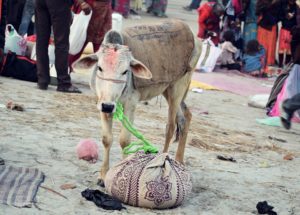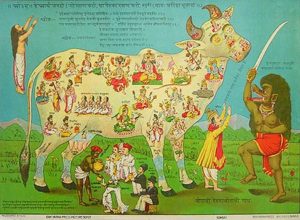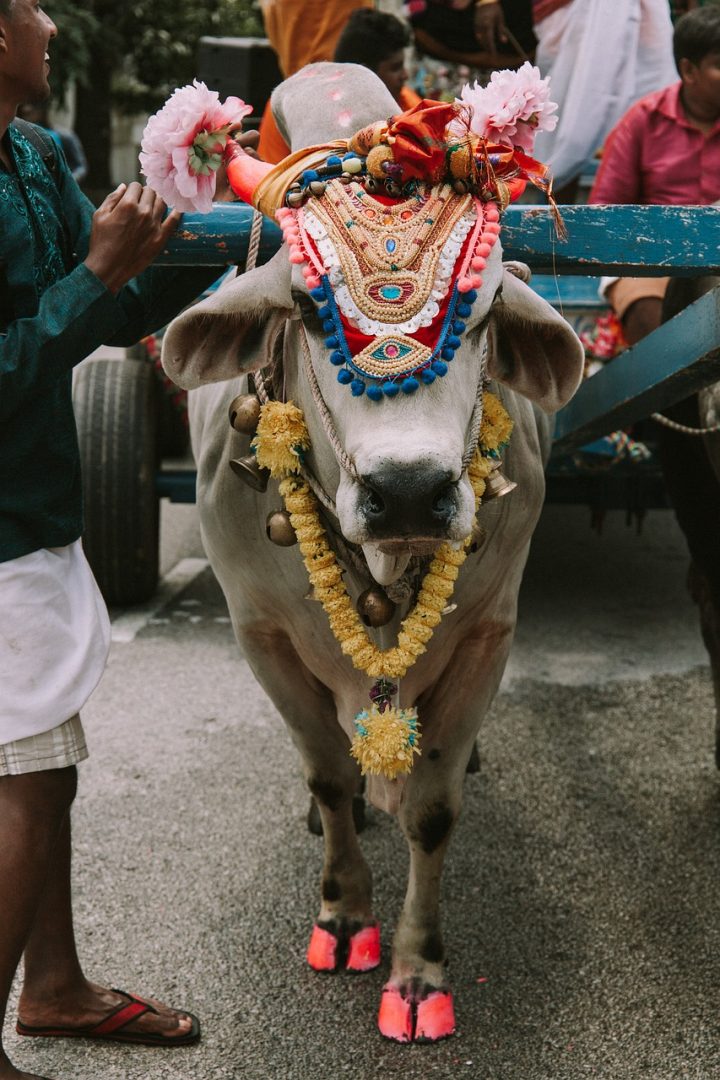Of all animals, the cow is considered to be the most sacred in the religious faith of Hinduism. Hinduism is the primary religious faith in India. Therefore, cows are considered sacred in Hinduism. Whenever you go to India, you will see that the cow is revered with the utmost respect. Even the cow has the right of way. Many in India take the reverence of the cow as a sacred symbol very seriously.
Why is the cow considered sacred?
But before then, it was permitted to eat meat in ancient India. It was forbidden to produce cows that produced milk. The slaughter of oxen and bulls were allowed.
 But, the ancient Vedic scriptures said that abstaining from eating meat would bring forth great benefits and rewards.
But, the ancient Vedic scriptures said that abstaining from eating meat would bring forth great benefits and rewards.
Eventually, for spiritual reasons, Hindus stopped eating beef. But, the slaughter of cattle was very expensive. At the same time, their cows are more valuable alive than dead. One reason is that the cow can produce a variety of things. It can produce milk. From that milk, comes the following: curds, cheeses, and butter. Its dried dung provides an excellent source of fuel.
Cow as a gentle spirit
Today, most rural Indian families have at least one dairy cow. That cow is considered a gentle spirit that is an important member of the family.
In the past, it is still unknown how the cow became sacred. The one possibility could come from the Vedic people with the scripture that talked about abstention from eating meat bringing forth many rewards. That could go into detail on the dairy products provided by the cow. The Vedic people depended on the cow for dairy products. Instead of getting meat, the people got curds, butter, cheeses, milk, and so forth. These could be examples of greater rewards than meat.
The cow dung could be used to fuel fires and fertilize lands. Yes, our lands are fertilized from excrements because of the nitrates. The nitrates are vital for maintaining good farmland.
Also, the burning of cow dung makes excellent mosquito repellent.
 Also, the cow could be used as labor for tilling the fields.
Also, the cow could be used as labor for tilling the fields.
Overall, the cow’s existence is that of the provider and a caretaker. It would be ungrateful to kill your “caretaker” to get some beef. Instead of beef, the cow’s milk can be used to create a variety of dairy foods. The dung as a fertilizer can help farmers grow their crops.
You’re knocking several things down with just one stone. That could be defined as the great rewards brought forth from abstaining from meat consumption.
In the Rig Veda scripture, the cow was very important. They were considered to be a symbol of wealth. If you have at least one cow, you are wealthy. If you have more than one cow, you are wealthier.
They also compared cows with the river goddesses.
At times, they symbolize the light. Cows could be considered as symbols of light to fight against the forces of darkness. The cow is considered to be a peaceful and gentle soul. Light is associated with being peaceful while the dark is associated with being chaotic.
In the Atharva Veda, the cow is the representation of the Hindu devas.
In the Harivamsha, it is depicted that the deity Krishna was a cowherd. Krishna is considered to be the protector of cattle. For the most part, the cow is a symbol of salvation because it produces milk that nourishes all. Again, one of the reasons that the cow is sacred is because of the milk that it can produce.
The cow is considered to be the highest gift.
This is similar to the Vedic scriptures on the milk being made into different products for consumption and that the dung can be made into fuel and fertilizer. Also, it adds that cow dung is used as a disinfectant.
Cow urine is used for medical purposes.
In the Puranas scripture, it is the same thing.
Regardless of how it originated from, the cow is considered a sacred symbol for good reason. When you look at the practicality, abstaining from beef consumption does bring forth many rewards.
Cows are like living and breathing eco-systems. They are their own eco-systems. They provide much for us. They demand little to nothing in return.






